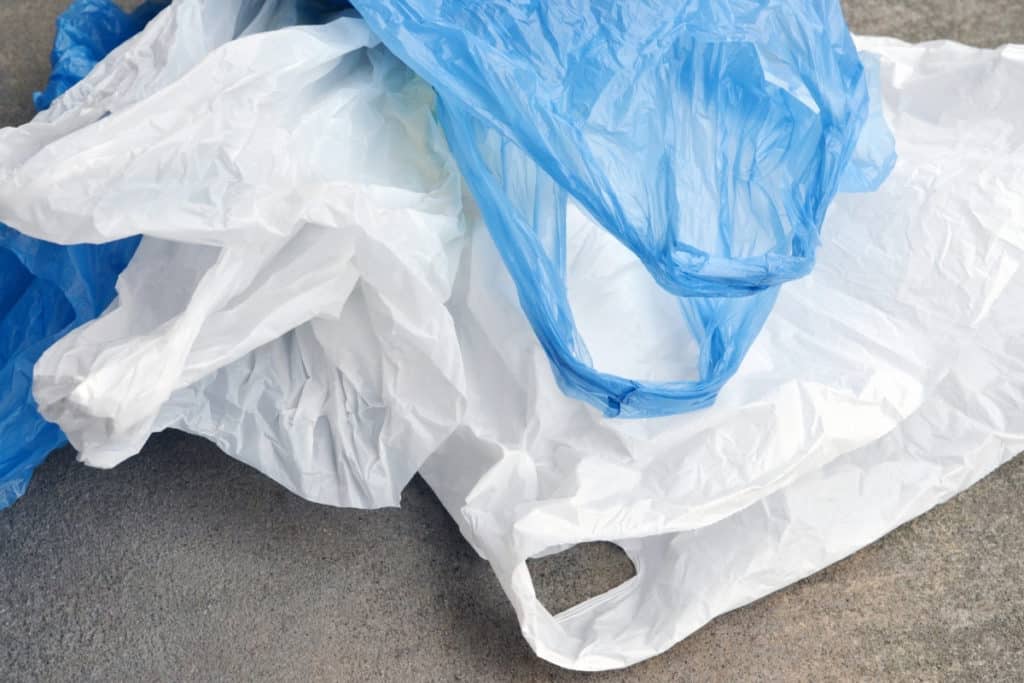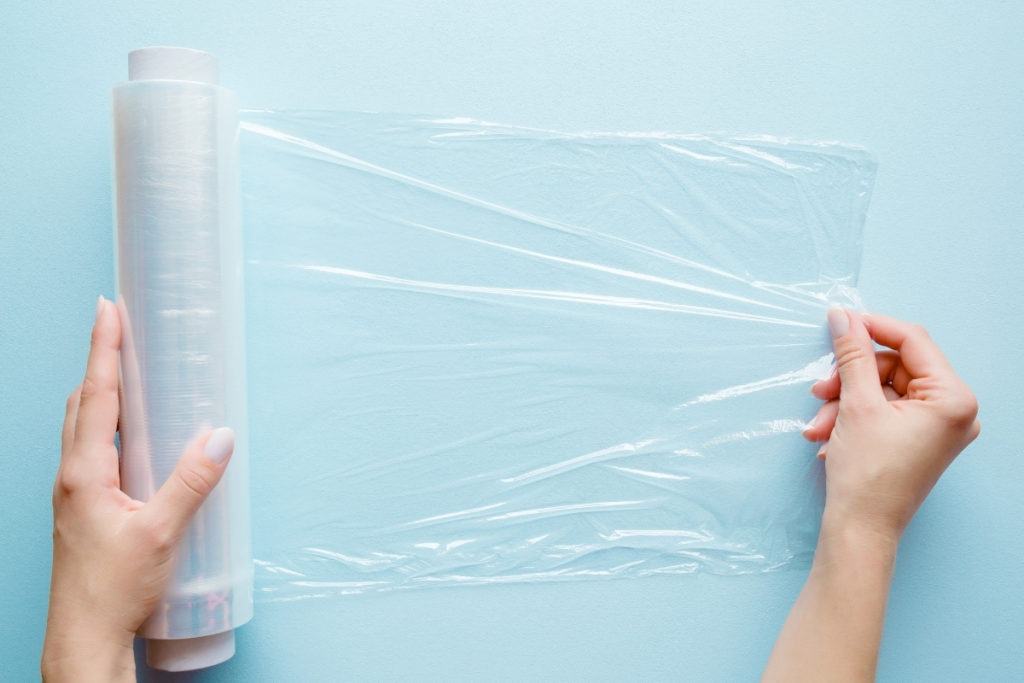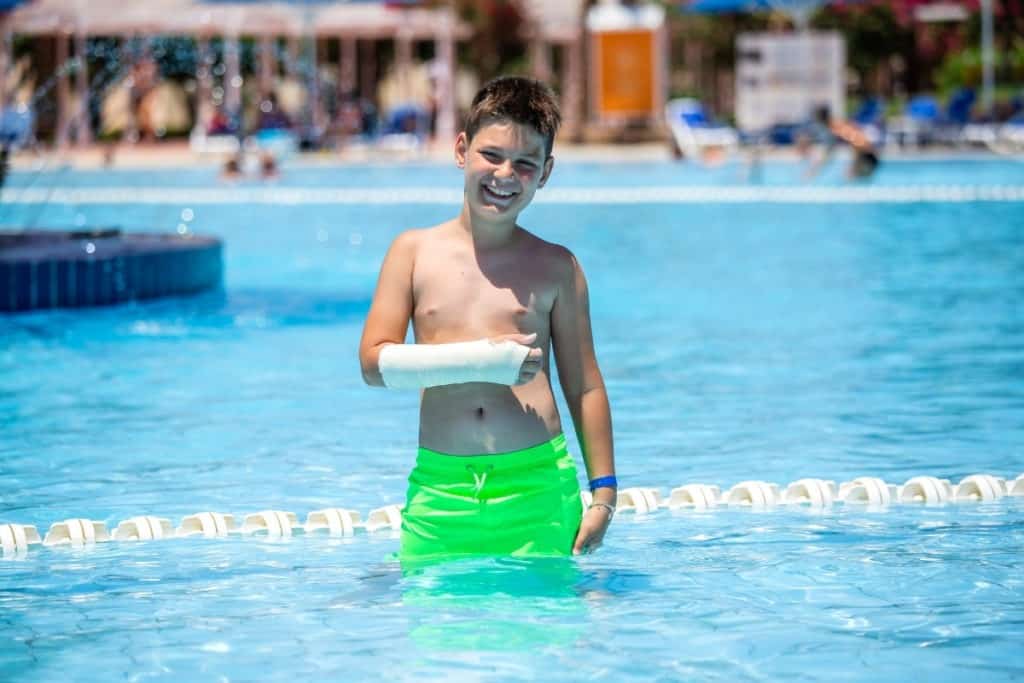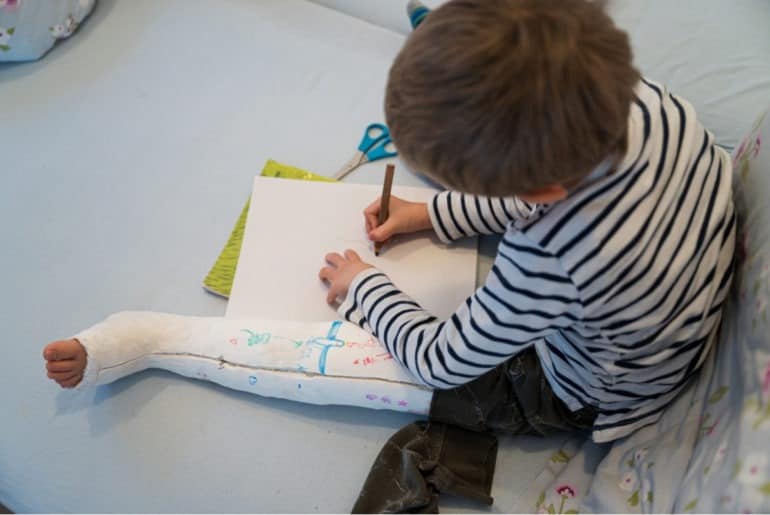Keeping a cast dry for six to eight weeks while maintaining proper hygiene is difficult for adults. For kids, the task can feel like it is near impossible. Many kids take showers or baths as part of their bedtime routines, and if you do not have a reusable waterproof cast cover handy or do not want to spend the money to buy one, then I have the perfect DIY solutions for a waterproof cast cover.
As a mom of a rambunctious seven-year-old boy whose energy just won’t quit and has no fear, I am shocked that I have yet to put cast care methods to practical use. Though, my adventurous two-year-old daughter may, in fact, be the one who breaks something first.
Why do you need to keep a cast dry?
The fiberglass on the outside of casts is water-resistant, so you may wonder why you need a waterproof cast cover. The problem lies in the interior of most casts. It is made of layers of cotton. If the inside padding gets wet, you can run into multiple issues. The biggest problem is that the break may not heal properly since it is no longer adequately supported. Getting the interior of your child’s cast wet can also cause it to become smelly, create skin issues, and become all-around uncomfortable.
DIY Waterproof Cast Cover
If you are leaning more toward a DIY waterproof cast cover because you are in a pinch or don’t want to buy a cast cover for a few weeks of use, there are a couple of ways you can make your own. Find them below.
Plastic Bag Cast Cover

The best bag to use for the plastic bag method will depend on if the cover is for your child’s arm or leg. Something small like a produce bag, bread bag, or a small trash bag may be the perfect size for an arm but may not be long enough for your child’s leg, depending on how high their cast goes and how tall they are. A newspaper sleeve is another excellent option that can work for either, especially if the leg cast is shorter. Medium to large trash bags work well for your child’s legs.
With any bag that you use, you will need to seal off the top. You can use tape such as medical tape or even duct tape if that is all you have lying around. However, that may rip the bag when you take it off and can irritate your child’s skin. If you want to reuse your cast cover, you can use a rubber band around the top to keep water out. It also keeps the bag from slipping and should cause minimal irritation to your child’s skin, though it may leave an indent.
If you use a plastic bag, make sure you grab one that does not have any holes! Also, this method is not meant to be submerged underwater. Try to stick to showers for the time being or keep the wrapped extremity out of the water while bathing.
Plastic Wrap

During the summer, plastic wrap gets a lot of use, keeping food airtight and bug-free. While it may be excellent at its job, it also is a decent DIY waterproof cast option keeping a cast reasonably dry. The key with this method is to make sure it is nice and tight. To keep it tight and waterproof, you will have to slowly wrap it around the cast, taking care not to leave any gaps or loose pieces. It may help to overlap each layer by a half-inch or so.
Plastic wrap is also incredibly cost-effective and pretty simple to apply. It may not be the quickest method, but it should provide a good barrier layer and protect the cast from water. Remember to use a rubber band, tape, or if you are over-cautious like me, both! This will keep the top end secure and keep the water out. The cast should not be submerged with plastic wrap on it, just to be on the safe side. Also, the plastic wrap may not be reusable. If you are super careful with removing it and keeping it dry, it may be possible, but generally, it is not worth the hassle.
DIY Waterproof Combination Method
If you do not want to rely on one method, you can combine the plastic wrap with the plastic bag. You would first wrap your child’s cast tightly with the plastic wrap. Find the appropriate size plastic bag with no holes and place it over the cast, securing it with a rubber band or tape.
This way, there is no room for error, and you can relax a little while your child showers. Even with the double layer of protection, do not fully submerge the cast.
Waterproof Cover Material

Some doctor’s offices have waterproof material that can go over your child’s cast. This material is designed with children in mind and allows the cast to get water on it. With the material, it will not sustain any harmful damage.
However, it does take a while before it dries completely. So only get the cast wet when it is entirely unavoidable. Also, a lengthy drying time may not be the best option if your child is taking a shower. Especially if they are heading to bed. No parent wants to delay bedtime because the cast needs to dry. You may still want to cover it with a plastic bag or an actual waterproof cast cover.
Waterproof Cast Covers

If you are resistant to the idea of a DIY cast cover and don’t mind buying something you may only use for a couple of weeks, many manufacturers make reusable waterproof cast covers. These are specifically designed to keep water off of your child’s cast. Many of these options can also be fully submerged. A few are even approved for swimming, which comes in handy during the summer months.
Final Wrap
Personally, I tend to lean more to the cautious side of DIY and would use the combination method or buy a reusable waterproof cast cover. Using both the plastic wrap and the plastic bag may feel like too many steps, but keeping that cast dry is far more critical than the extra 5-10 minutes it may take to ensure the cast is completely covered. When your kiddo’s ultimate comfort and hygiene are at stake, there is no room for error.






Comments are closed.